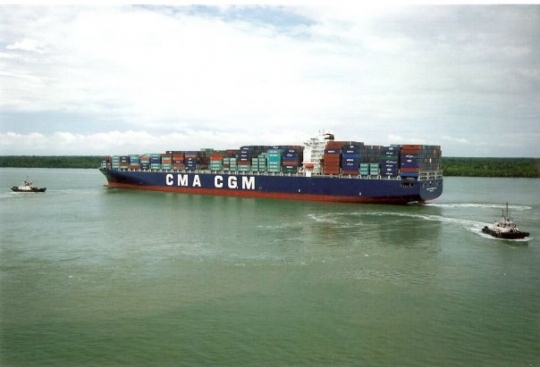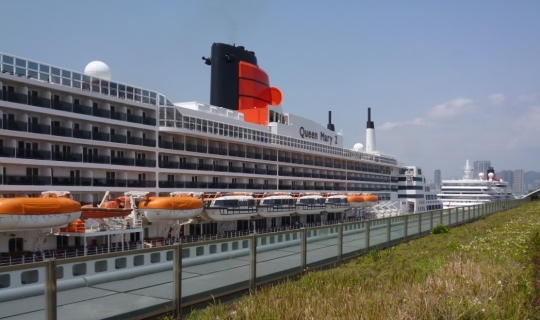With jumbo-sized poignancy an amusing thought struck me recently; and it was all to do with the very spot on which I stood. You see, had I been there during my previous Hong Kong life, I’d certainly have risked arrest for being a loony or, even worse, flattened by flight BA27 on its arrival from London Heathrow. But no more, the planes have gone and the site having undergone an audacious change of use now accommodates, would you believe, cruise ships!Now there can’t be too many instances where an international airport is, admittedly with a bit of clever civil engineering, converted into a cruise ship terminal. After all, aviation and seafaring are two very different animals with, not to put it too finely, extremely different needs. But here in Hong Kong such things happen with unnervingly regularity.
So my only danger in this area nowadays comes from tour buses, taxis and a phalanx of disembarking holiday makers emerging from a very smart new terminal building (courtesy of Foster + Partners) at the far end of what used to be called Runway 13.
To those unfamiliar with Hong Kong I should explain that air traffic at the old Kai Tak Airport, then the world’s third busiest and sixth most dangerous (hemmed in by hills and buildings), had simply outgrown the plot and action was urgently needed, so in 1998 it moved. Overnight, equipment and staff were relocated, the lights switched off and the doors locked before seamlessly starting up again, barely a few hours later, at a new destination 30 kilometres west. You know how stressful moving house can be, imagine trying to do all that with an international airport and all its technical trimmings.
Anyway, that left the existing Kai Tak site, with its runway jutting out into Kowloon Bay, available for alternative development. So, after much deliberation government came up with the bright idea of converting the end of Runway 13 into a cruise ship terminal, coincidentally the existing Ocean Terminal in Tsim Sha Tsui had befallen a similar fate as Kai Tak: burgeoning demand and an inability to cope with the ever increasing size of modern vessels. So the famous and much-loved air hub would continue to hub but in a maritime capacity. The downside off all this was that aviation enthusiasts lost a gem of derring-do while the keen cruisers lost their beloved and very convenient city-centre berth; that’s life of course, though not all would call it progress.
Nevertheless, the purpose of our visit which, as well as being a nice day out, was to indulge a sense of aviation nostalgia as well as tick off a few of life’s more prominent anniversaries. By coincidence, and an interesting draw for us, was that this day had also been chosen by Cunard as the meeting place for the Queen Mary 2 and the Queen Elizabeth, something they regularly organise should two of their vessels be able to meet during their respective world cruises. Although impressively big and glitzy looking, signature red funnels and gleaming white superstructure, they could not in our humble opinion compete style-wise with their historic predecessor the QE2.
And that brings us nicely to our first anniversary which marks our leaving Hong Kong for good aboard the QE2 some 14 years ago. It was also our first time on a cruise and although we’re not cruisers per se they do provide a perfect means of getting somewhere. Sailing off into the sunset was a wonderful thing to do, a very classy way of moving house you might say but not cheap. Nonetheless, for the chance of experiencing one of travel’s greatest ever icons it was worth every penny.
Well, after 12 years in Hong Kong you couldn’t just get on a scheduled airline and fly off could you? Of course, those of you familiar with this column will know that that particular leaving Hong Kong for good wasn’t for good at all and we returned a few years later, another anniversary, jumping ship at this very place virtually three years ago to the day.
So, in the shadow of these contemporary queens we remembered that occasion too though admittedly back then we’d slipped down market a tad by sailing aboard Fred Olsen, no offence Fred. As it happened Fred scored highly on convenience while the means to fund another queenie voyage no longer existed, never mind. We also remembered that some wreckage of what was the original Queen Elizabeth, having suffered an unfortunate accident, still graces the bottom of the harbour almost within sight of where we were; but not wishing to upset the party prudence told us not to bang on about it.
The cruise terminal was also a good place to remind ourselves how over the years Hong Kong had been shaped by enterprising travellers who crossed the border on foot or arrived by ship and settled, and the many more that didn’t but simply passed through. Although Hong Kong was founded on trade, modern times yielded an influx of business seekers taking advantage of its fabled Gateway to China and they in turn paved the way for the tourist droves that followed; it is to these people that a significant support industry has arisen.
And that’s one thing that makes living in Hong Kong quite exciting, although it’s forever in a state of flux there’s still an enormous amount of outside influence and admittedly it’s fascinating to live in a place that people genuinely yearn to visit. Having said that I wonder if the various travel sector organisations who claim Hong Kong to be the most visited city on Earth might be somewhat biased, I was always led to believe that Paris wins that accolade by a country mile; perhaps they count visitors differently. Either or, Hong Kong’s attraction remains undiminished and another arrow in the city’s quiver is that you can arrive by plane, ship, train, bus, car or even foot, and there aren’t too many places where you can do all of those.
And that returns me nicely to the underlying theme of this article which is travel, and more specifically travel related to Hong Kong which isn’t all about arriving groggily jet-lagged at a soulless airport building; is it me or has modern-day flying really become so awful, something to be avoided if possible? But worry not for options abound as our cruise terminal visit suggests.
Though even if cruises aren’t quite your cup of cha, and I can see how they mightn’t be, there are ways of arriving which neatly avoid having to endure any time on an Abomination of the Seas or other such horrendous leviathan.
What many travellers and indeed some residents might overlook is the enormous range of cargo ships which ply their trade around these parts. A few years ago we ended a brief Hong Kong visit by returning to England via a container ship operated by the French company CMA CGM. Although we didn’t have a clue what to expect it’s true to say that within minutes of the ship passing below the elegant Stonecutter’s Bridge and away from the Kwai Chung Container Terminal we were converts. Getting close up to the workings of such a vessel, her crew and daily regimen was an absorbing experience, as much about maritime engineering as travel itself; and a three week sojourn on the high seas certainly brings home exactly how large our planet really is.
So when people say it’s a small world I’d advise strongly on taking such a voyage if you feel it’s a view that needs redressing. One big advantage of a cargo ship is that you are spared the inane entertainment and daily activities which cruise lines seem desperate to inflict, as if we need distracting from the seafaring side of things or might be prone to an unfortunately short attention span. On a cargo ship however it’s all about the sea, cargo is king they stress, not you; passengers make their own entertainment and on occasion themselves turn out to be thus as ship’s crew are keen to get to know you, fresh faces understandably make a welcome inclusion on a three month stint. If you fancy this approach there are travel agents which deal specifically in cargo ship journeys or you can contact a shipping company or their port agents direct.

Another of Hong Kong’s new transportation wonders due to commence service this September is a high-speed train link north to China’s Guangzhou, or Canton as it used to be called in days of yore. This will link Hong Kong into the mainland high-speed system and will enable direct journeys to a smattering of Chinese cities; most notably Beijing and Shanghai in nine and eight hours respectively. That’s all very well though not a lot of people, including residents, appreciate that it is possible to do that already, but not so high-speed of course.
In Hong Kong many people think of the Through Train as a euphemism for the political shenanigans sparked off between UK and China prior to the handover. This Through Train concept was intended to provide a stable government capable of straddling the transfer of sovereignty. I won’t bore you with the details except to say it didn’t quite work out as intended but we did nevertheless gain a real Through Train which hasn’t as yet suffered any terminal derailments real or figurative.
Yes, you can indeed travel by train direct from Hong Kong to Beijing or Shanghai though at a significantly slower pace, Beijing for example is a 24-hour overnight sleeper service. It’s without doubt our favoured mode of getting to the capital, what’s not to like? Basic but perfectly adequate, great restaurant car, fascinating views seemingly on to every facet of Chinese life, be it rural, industrial or city, it’s like watching an expertly made documentary as you dawdle pleasingly along, Tsing Tao beer to hand.
So fellow passengers it’s all change at Hong Kong as we attempt to fit in yet more flights, cruises and trains; though I’m not convinced that being able to shift the masses around more quickly and with greater ease and comfort is necessarily a good thing.
You’ve probably guessed by now that these days we’re committed members of the slow travel club, in fact the slower the better; hence our preference of unhurriedly getting along overland or overseas. For an idea of slow it’s easy to imagine how things used to be in the dark and distant past. In this context I’m fond of quoting the British novelist and travel writer Ethel Mannin who, in her book The Flowery Sword (1960), recounted a trip to Japan. They took what she described as ‘the conventional route’ flying ‘via Dusseldorf, Zurich, Cairo, Bombay, Calcutta, Bangkok, and Hong Kong’, putting down at good old Kai Tak of course! Imagine all that though? A journey of a few days with several stops compared to 12 direct hours today.
Perhaps we now fully appreciate T.S. Eliot’s adage in which it’s the journey not the arrival that matters more, though I wonder if that’s an age thing too. Maybe not, interestingly I have noticed a recent trend by which some younger travellers on round-the-world adventures, an activity traditionally achieved on an all-in air ticket, attempt to complete their circumnavigation with minimal recourse to flying; again it’s the slow travel theme but in today’s world it’s also born of a modern, conscientious desire to meet green and sustainability targets – it’s also travelling in the true sense of the word. So what do you think? How would you like to arrive, or indeed leave, Hong Kong? Let us know, we’d love to see you here!

